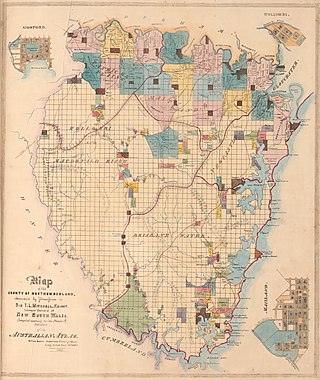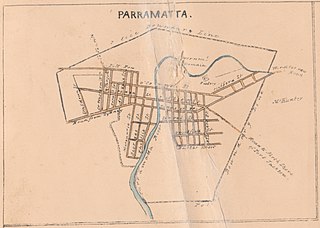Related Research Articles
Stanley Boroughs was an electoral district for the Legislative Assembly in the Australian state of New South Wales created in 1856 election, named after the County of Stanley and including the towns of North Brisbane, South Brisbane, Kangaroo Point and Ipswich. The surrounding rural parts of the County of Stanley were in Stanley County. It was abolished in 1859 and replaced with Brisbane and Ipswich.
East Moreton was an electoral district of the Legislative Assembly in the Australian state of New South Wales created for the July 1859 election, partly replacing Stanley County in the Moreton Bay region around Brisbane. It was abolished in December 1859, as a result of the Separation of Queensland.
The United pastoral districts of Moreton, Wide Bay, Burnett and Maranoa, and from 1857 Moreton, Wide Bay, Burnett, Maranoa, Leichhardt and Port Curtis, was an electoral district of the Legislative Assembly in the Australian state of New South Wales created in 1856 and consisted of the pastoral districts around the early settlements of Moreton Bay; Wide Bay, near Maryborough; the Burnett River, near Bundaberg; and the Maranoa region of South-western Queensland. In September 1856 the pastoral districts around the Leichhardt River in the Gulf of Carpentaria region and Port Curtis (Gladstone) were added to the electorate. The district was abolished for the 1859 election and replaced by the separate districts of East Moreton, West Moreton, Burnett and Leichhardt, while Maranoa became part of Darling Downs. All of these districts became part of Queensland when it was established as a separate colony in late 1859.
This is a list of members of the New South Wales Legislative Council from 1851 to 1856. The 1851 Electoral Act increased the number of members in the Council to 54, 18 to be appointed and 36 elected. The initial appointments were made in October 1851. The Speaker was Charles Nicholson.

The Electoral district of Counties of Gloucester, Macquarie, and Stanley and from 1851, Gloucester and Macquarie, was an electorate of the partially elected New South Wales Legislative Council, created for the first elections for the Council in 1843. The counties of Gloucester and Macquarie were the settled coastal areas north of Northumberland County, while the County of Stanley was the area surrounding Brisbane, in what became part of Queensland after its separation in 1859. Polling took place at Raymond Terrace, Port Macquarie, Dungog, Stroud, Brisbane, Ipswich and Mr Rowley's residence on the Manning River. The County of Stanley was removed from the district with the expansion of the Council in 1851 and became the districts of County of Stanley and Stanley Boroughs.

Francis Edward Bigge (1820—1915) was a pioneer pastoralist and politician in Queensland, Australia. He was a Member of the New South Wales Legislative Council and a Member of the Queensland Legislative Council. He championed the development of Cleveland on Moreton Bay. He was influential in achieving the separation of Queensland from New South Wales, but did not succeed in making Cleveland the capital of Queensland.
The 1856 New South Wales colonial election was to return 54 members of Legislative Assembly composed of 34 electoral districts with 18 returning 1 member, 13 returning 2 members, two returning 3 members and one returning 4 members, all with a first past the post system. In multi-member districts, because each voter could cast more than one vote, it is not possible to total the votes to show the number of voters and voter turnout in these districts is estimated. 8 members from 6 districts were returned unopposed.
Richard Jones was an English-born politician in New South Wales and Queensland, Australia.
Henry Hughes was an Australian pastoralist and politician.
The electoral district of Cumberland Boroughs, also known as the united towns of Windsor, Richmond, Liverpool and Campbelltown, was an electorate of the New South Wales Legislative Council at a time when two thirds were elected, one sixth were official members, that is they held a government office and the balance were appointed by the Governor.

The Electoral district of Northumberland Boroughs was an electorate of the partially elected New South Wales Legislative Council, created for the first elections for the Council in 1843. From 1843 until 1851 the electorate covered the major towns or boroughs of Northumberland County, East Maitland, West Maitland and Newcastle, and polling took place at East Maitland, West Maitland and Newcastle. Morpeth was added to the electorate from 1851 while Newcastle was removed from the electorate to form, with Raymond Terrace, the North Eastern Boroughs. The rest of Northumberland County was covered by the County of Northumberland from 1843 until 1951, and Counties of Northumberland and Hunter from 1851 until 1856.

The Electoral district of Town of Parramatta was an electorate of the partially elected New South Wales Legislative Council, created for the first elections for the Council in 1843, at the time the principal residence of the Governor Sir Charles FitzRoy. Polling took place at Parramatta. In 1856, the unicameral Legislative Council was abolished and replaced with an elected Legislative Assembly and an appointed Legislative Council. The district was represented by the Legislative Assembly Parramatta, the only electorate to have existed continuously since the first Legislative Assembly election in 1856.
The 1851 New South Wales colonial election, was held between 12 and 25 September. It involved a re-distribution of electorates as a result of the separation of Victoria, which had 6 seats in the previous council, and the expansion of the council from 24 elected members to 36 elected members representing 31 electorates. The major changes were the addition of 8 pastoral districts and the separate representation for the northern regions of what would later become Queensland. These had previously been a part of the single district of Gloucester, Macquarie, and Stanley and from 1851 were covered by the separate districts of Stanley, Stanley Boroughs and the pastoral districts of Moreton, Wide Bay, Burnett, and Maranoa. The other 8 additional seats were distributed among the nineteen counties of New South Wales.
The Electoral district of Pastoral Districts of New England and Macleay was an electorate of the New South Wales Legislative Council at a time when some of its members were elected and the balance were appointed by the Governor. It was a new electorate created in 1851 by the expansion of the Legislative Council to 54, 18 to be appointed and 36 elected. The district is located in the north of the state and covered the Northern Tablelands region of New England and part of the Mid North Coast region, including the area to the north of the Macleay River, but excluding the area south of the Macleay River which was included in the Counties of Gloucester and Macquarie. To the north was the Pastoral Districts of Clarence and Darling Downs and to the west the Pastoral Districts of Liverpool Plains and Gwydir. Polling took place in the towns of Wellingrove, Armidale, Tenterfield, Walcha and Kempsey.
The Electoral district of Pastoral Districts of Moreton, Wide Bay, Burnett, and Maranoa was an electorate of the New South Wales Legislative Council at a time when some of its members were elected and the balance were appointed by the Governor. It was a new electorate created in 1851 by the expansion of the Legislative Council to 54, 18 to be appointed and 36 elected. The district was named after the early settlements of Moreton Bay; Wide Bay, near Maryborough; the Burnett River, near Bundaberg; the Maranoa region of South-western Queensland. These became part of Queensland on its establishment in 1859.

The Electoral district of County of Stanley was an electorate of the New South Wales Legislative Council at a time when some of its members were elected and the balance were appointed by the Governor. It was a new electorate created in 1851 by the expansion of the Legislative Council to 54 members, with 18 to be appointed and 36 elected. The previous district of Counties of Gloucester, Macquarie, and Stanley was split into the districts of Gloucester & Macquarie, Stanley and Stanley Boroughs, which included North Brisbane, South Brisbane, Kangaroo Point and Ipswich.
The 1858 New South Wales colonial election was to return 54 members of Legislative Assembly composed of 34 electoral districts with 18 returning 1 member, 13 returning 2 members, two returning 3 members and one returning 4 members, all with a first past the post system. In multi-member districts, because each voter could cast more than one vote, it is not possible to total the votes to show the number of voters and voter turnout in these districts is estimated. 17 members from 14 districts were returned unopposed. The electoral districts and boundaries were established under the Electoral Act 1851 (NSW) for the former Legislative Council.
The United pastoral districts of Moreton, Wide Bay, Burnett and Maranoa and from 1857 Moreton, Wide Bay, Burnett, Maranoa, Leichhardt and Port Curtis, an electoral district of the Legislative Assembly in the Colony of New South Wales was created in 1856 and abolished in 1858.
The 1851 New South Wales colonial election was held between 12 and 25 September. This election was for 36 seats in the New South Wales Legislative Council. The 1848 election had been for 5 year terms however the parliament had been reconstituted following the separation of Victoria. At the same time the council was expanded from 36 to 54 members. The Legislative Council was a hybrid system with 18 appointed members and 36 elected. The Port Philip districts had 6 elected members, which meant there were an additional 18 seats. There were 3 new districts for the northern regions of what would later become Queensland, Stanley, Stanley Boroughs and the pastoral districts of Moreton, Wide Bay, Burnett, and Maranoa and 7 new pastoral districts in western New South Wales. The other 8 additional seats were distributed among the nineteen counties of New South Wales.
References
- 1 2 "An Act to provide for the division of the Colony of New South Wales after the separation of the District of Port Phillip therefrom into Electoral Districts and for the Election of Members to serve in the Legislative Council.". Act No. 48 of 2 May 1851 (PDF). Australasian Legal Information Institute. Retrieved 15 September 2014.
- 1 2 "Mr Richard Jones [1] (1786–1852)". Former members of the Parliament of New South Wales . Retrieved 21 April 2019.
- ↑ "Mr Henry Stuart Russell (1818-1889)". Former members of the Parliament of New South Wales . Retrieved 21 April 2019.
- ↑ "Mr John Richardson (1810-1888)". Former members of the Parliament of New South Wales . Retrieved 21 April 2019.
- ↑ "Noimnations for the county of Stanley and the Stanley Boroughs". The Moreton Bay Courier . 13 September 1851. p. 3. Retrieved 30 May 2019– via Trove.
- ↑ "Election for the Stanley Boroughs". The Moreton Bay Courier . 8 January 1853. p. 3. Retrieved 31 May 2019– via Trove.
- ↑ "Election for the Stanley Boroughs". The Moreton Bay Courier . Queensland, Australia. 10 September 1855. p. 1 (Supplement to the Moreton Bay Courier). Retrieved 31 May 2019– via Trove.